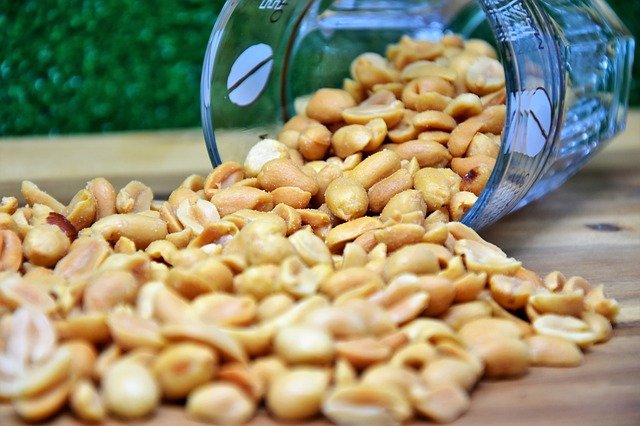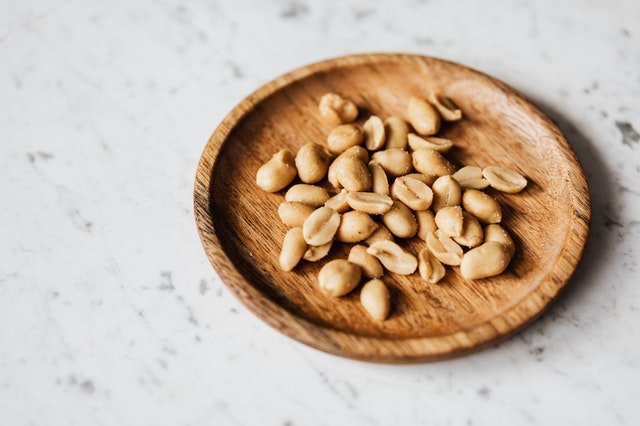
Peanuts (or peanuts) are a protein food whose regular consumption is associated with several health benefits.
Peanuts (also known as American peanuts), originally from South America but cultivated today in different parts of the world, are the fruits of a herbaceous plant, Arachis hypogaea, belonging to the Fabaceae family; they appear dark yellow with an irregular oval shape and are covered with a thin reddish skin.
Rarely consumed raw, peanuts are generally preferred roasted (salted or not), in the form of cream or peanut butter, made famous thanks to Hollywood films, or consumed in stir-fries and in various recipes of the kitchen around the world as oil of peanut seeds.
Although many would not say it, despite the crunchy texture, high fat content and good presence of vitamin E, peanuts are not technically nuts or oil seeds, but belong to the legume family (legumes) and are therefore cousins of foods such as beans, lentils, chickpeas and soy.
Peanuts: calories and nutritional values
Peanuts have nutritional properties halfway between legumes and nuts, acquiring the best characteristics from both categories of food.
As for energy intake, peanuts provide 567 calories per 100 grams of edible portion and, like all legumes, are good sources of vegetable protein and fiber. Furthermore, the presence of good fats (mainly monounsaturated) helps to limit the glycemic index. Specifically, the fat content of peanuts is approximately 50% and it is mainly mono and polyunsaturated fats and oleic acid and linoleic acid (essential fatty acid of the Omega-6 series) are particularly present.
Furthermore, as we have said, the protein content of peanuts is quite high (¼ of the weight), making these fruits particularly interesting for consumption by vegetarians or vegans. Furthermore, the richness in proteins, fibers and the low sugar content makes them the ideal food also for those suffering from glycemic dysregulations (PCOS, type 2 diabetes ..).
As for vitamins and minerals, they are characterized by a good content of B vitamins, vitamin E, potassium and copper. The intake of folate is also good, so much so that 100 g provide 240 mcg (more than double that of hazelnuts) which corresponds to about 60% of the recommended daily dose.
In peanuts we also find a good quantity of phytosterols, the most common of which is β-sitosterol, which would act in the intestine in reducing the absorption of cholesterol.
Finally, it should be emphasized that these foods also contain molecules with antioxidant action. In this regard, according to a study, the cooking process would affect the bioavailability of the antioxidant molecules present in peanuts. In particular, boiled peanuts have the highest content of flavonoids and polyphenols with values of biocanin A and genistein of two and four times respectively higher. Roasting, on the other hand, increases the levels of p-coumaric acid(another molecule with antioxidant action) and helps to remove aflatoxins, antinutrients present in fresh legumes. For greater clarity, we report below the table with the nutritional values of peanuts.
Nutritional values per 100g of peanuts:
- Waterfall: 6.5 g
- kcal: 567
- Proteins: 25.8 g
- Fat: 49.24 g
- of which saturated: 6.279 g
- Carbohydrates: 16.13 g
- of which sugars: 4.72 g
- Fibers: 8.5 g
- Potassium: 705 mg
- Phosphorus: 376 mg
- Niacin (vit.B3): 12.066 mg
- Choline: 52.5 mg
- Glycemic index: 14
- Cholesterol: 0 g
Peanuts: health benefits
The synergy of all these nutrients gives peanuts useful properties for our health. In short, peanuts are good for the heart, help reduce cholesterol, are useful in case of diabetes and preventive action against the formation of gallstones. Let’s explore the benefits of regular consumption of these foods below.
✓ Cardiac health
Thanks to the pool of elements that contain, such as potassium, magnesium, vitamin B3, copper, oleic acid and various molecules with antioxidant action, including resveratrol, the regular and controlled intake of peanuts would favor the reduction of bad cholesterol (LDL) and triglycerides while increasing the levels of good cholesterol (HDL), thus preventing cardiovascular diseases such as heart attack which is one of the main causes of death in the world.
✓ Prevention of gallstones
Two observational studies showed that the consumption of peanuts is able to reduce the risk of developing gallstones in both men and women thanks to the cholesterol-lowering effect they cause, as most gallstones are largely made up of cholesterol. However, further studies are needed to confirm these results.
✓ Useful in case of diabetes
Peanuts are a useful food in case of diabetes or for those at risk of diabetes. Specifically, these foods help control blood sugar levels thanks to their low glycemic index and good fat, protein and fiber content. These, in particular, slow down digestive processes and allow a more gradual release of blood sugar, also avoiding glycemic peaks.
✓ Peanuts promote weight loss
Despite being rich in fats and having a high caloric density, American peanuts seem useful in promoting weight loss, as long as you do not exceed the quantities as thanks to the quantity of proteins, fibers and good fats they present, they determine a satiating effect prolonged over time.
Peanuts: how many to eat
Although peanuts belong to the legume family, we find them more often in the food group of nuts due to their nutritional characteristics.
The recommended portion of peanuts is about 30g (weight referred to raw food and net of waste) and provides 186 kcal, mainly from mono and polyunsaturated fats (the famous good fats). It is possible to take from one to three servings of nuts per week, therefore, for a varied diet, it is advisable to alternate the consumption of peanuts with other types of dried fruit (almonds, walnuts, hazelnuts etc …).
Salted, caramelized or plain peanuts: which one to choose
In relation to the type of products on the market we can find:
✓ Salted peanuts
Salted peanuts are first roasted and then salted, they are the classic aperitif snacks. Salted peanuts are among the foods rich in sodium, therefore their consumption must be sporadic as it is known that excessive consumption of salt and salty foods can have, in the long term, negative effects on our health. Furthermore, the consumption of salted peanuts is not recommended for those who must follow a low -sodium diet.
✓ Caramelized peanuts
The caramelized peanuts are toasted and then topped with a syrup made with water and sugar that creates the crunchy outer frosting. Although they are highly appreciated for their sweet taste and crunchy texture, excessive consumption of caramelized peanuts is not recommended due to the high content of simple sugars. In particular, their intake is not recommended for those suffering from diabetes or other diseases for which it is necessary to limit the intake of simple sugars.
✓ Natural peanuts
Natural peanuts are usually available already roasted with or without pods, these are preferable to the salty and caramelized type since, having no other added ingredients, they preserve intact the taste and nutritional characteristics. Natural peanuts can be consumed during the week as an alternative to almonds, walnuts, hazelnuts and other nuts as long as the recommended portion is respected, which is equivalent to 30g.
Peanuts: how to use and store them
In addition to being eaten plain as a simple hunger-break snack, here are some ideas for adding peanuts to your daily diet:
- In the morning, for breakfast, add some chopped peanuts to yogurt or a fruit salad;
- The chopped peanuts can be used to create a healthy, crunchy and very tasty breading for your dishes;
- If you are lactose intolerant, follow a vegan diet or simply love to experiment in the kitchen, you should try peanut milk, an energetic and nutritious drink, suitable for everyone;
- Add a teaspoon of peanuts (even chopped) to your next salad;
- If you need to fry, use peanut butter: it has a high smoke point and has resistance to oxidation, so it is excellent both for cooking at medium-low temperatures and for frying.
The conservation of peanuts is fundamental: if enclosed in their shells they must be stored in a cool and dry place and maintain their characteristics even for many months, while once shelled they must be placed inside an airtight container and stored in the refrigerator to avoid rancidity of fats.
How to make peanut cream
The peanut cream can be easily self-made at home, you only need toasted (unsalted) peanuts and a blender. The difference with peanut butter is that the latter also involves the use of oil and sometimes honey or sugar. Here, however, we will see how to make peanut cream.
Ingredients (for 1 jar): 300 gr of unsalted roasted peanuts
Procedure:
- Put the peanuts in your blender and run it at high speed. The peanuts will become a grain. Stop the blender, remove all the grain from the sides of the blender, then turn it back on at high speed.
- Gradually the grain will become finer and finer, the peanuts will begin to naturally release their oil and a cream will form. In a few minutes you will have created your own peanut cream!
- Transfer it to a jar and store in the refrigerator.
Peanuts: potential negative effects and contraindications
- Aflatoxin poisoning: Peanuts can sometimes be contaminated with a mold (Aspergillus flavus) that produces a toxic substance called aflatoxin. The main symptoms of aflatoxin poisoning include loss of appetite and jaundice (yellowing of the eyes) which is the typical sign of a liver problem. Severe aflatoxin intoxication can even cause liver failure and liver cancer. The risk of aflatoxin contamination depends on how the peanuts have been stored it is therefore important to prefer a dry place, at low humidity and temperature, away from heat sources;
- Antinutrients: peanuts, like all plant seeds, contain a series of so-called antinutrients, these are substances that alter the absorption of nutrients and the most represented is phytic acid whose percentage in peanuts varies from 0.2 to 4.5%. Phytic acid impairs the absorption of iron and zinc from the digestive tract, so excessive consumption of peanuts can contribute to the lack of these minerals over time;
- Peanut allergy: Peanuts belong to the group of the 8 most common food allergens. Peanut allergy is potentially life-threatening, so much so that these fruits are considered to be the most serious allergen. In less severe cases (and, fortunately, more common), peanut allergy manifests itself with symptoms such as itchy skin, burning throat, stomach pain, diarrhea, vomiting or intestinal swelling. Furthermore, peanut allergy is related to cross-reactivity, so it is good to pay attention even if another allergy to legumes or oily nuts is already known. People with peanut allergy should avoid peanut consumption and also pay particular attention to the ingredient list of industrial products they purchase to be sure that no trace peanuts are contained;
- Nickel: Peanuts have a fair amount of nickel, therefore, people allergic to this metal should be careful with their consumption, especially if excessive.






